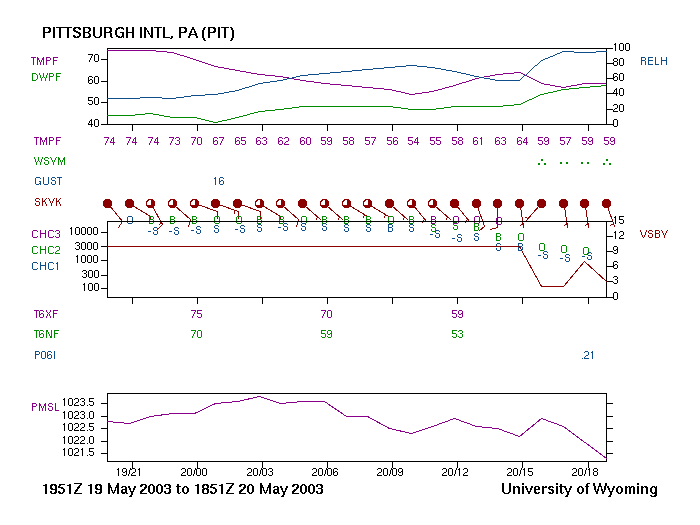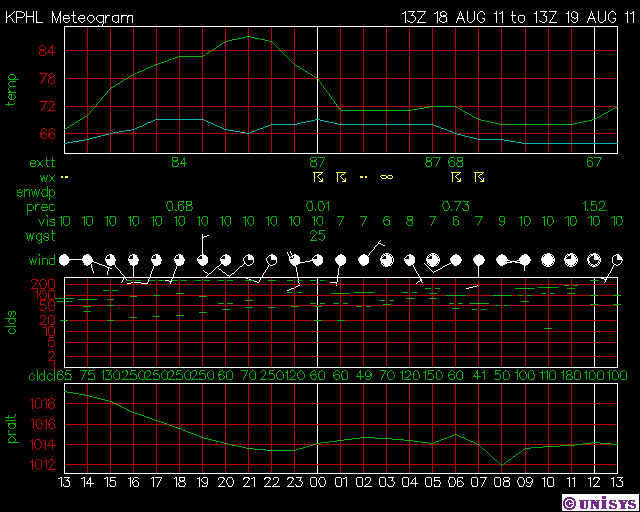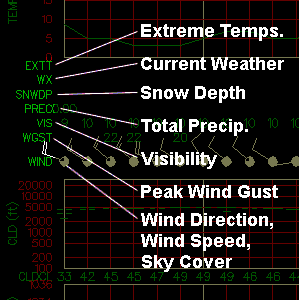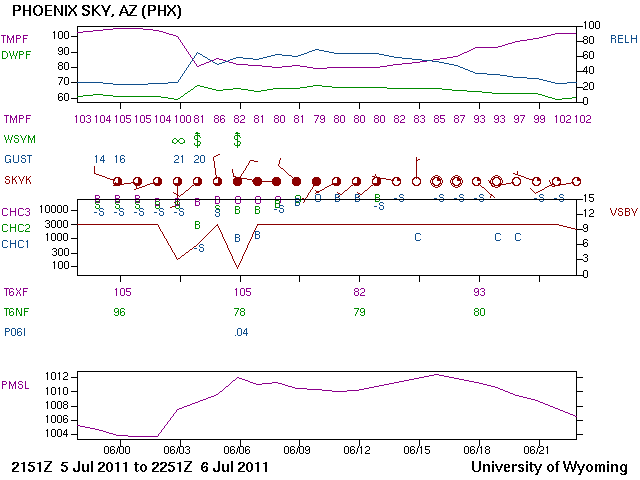 Prioritize...
Prioritize...
The emphasis of this lesson has been making sense out of all the data available to meteorologists. So far, we have mainly been looking at how to display data that varies in space but has been collected at a single time. In this section we will discuss the use of the meteogram -- a way of displaying a time-history of data from a single station. Upon finishing this section, you should be able to interpret meteograms from both Unisys and the University of Wyoming. Read...
Read...
For most of this lesson we have been looking at how to better visualize data in space (at a single time). In this section, we're going to change gears and look at how to visualize a series of observations (over a period of time) at a single station. For the record, a meteogram (formally called a meteorogram) typically displays observed or predicted atmospheric variables (temperature, dew point, wind, etc.) at a single station over a period of time (usually 24 hours or, 25 hourly weather observations). While there is no "official" set of rules for creating a meteogram, many of the ones that you will find on the Internet share some common characteristics. The important concept here is to know what a meteogram is showing (in general) and then sort out where/how all of the various pieces of data are displayed. We will look at the two most common meteograms: those produced by the University of Wyoming and, those found on the Unisys website.
University of Wyoming Meteograms
Meteograms from the University of Wyoming Atmospheric Sciences website can be generated for a wide variety of times and locations. To create your own meteograms from this Web site, first use the menu on the left to choose a region of interest. In the second menu (from the left) scroll down and select "GIF Meteogram". Then click on the dot representing the city or town of interest on the map displayed. What will appear is a meteogram like the sample below.
To first thing to do before diving into the data is to get your bearings. Notice that the times and dates covered by the meteogram appear at the bottom of the image. This meteogram from Pittsburgh, Pennsylvania, spans from 1951Z on May 19, 2003 to 1851Z on May 20, 2003. Note the "tic" marks (short, vertical line segments) along the bottom of the first rectangular plot. Each "tic" mark represents a "synoptic time". By convention, "synoptic times" are 00Z, 03Z, 06Z, 09Z, 12Z, 15Z, 18Z, and 21Z. So, on this particular meteogram from Pittsburgh, the first "tic mark" represents 21Z on May 19, the first synoptic time after 1951Z on May 19. The second from the left "tic mark" corresponds to 00Z on May 20; the third from the left corresponds to 03Z; and so on and so forth. Just in case you have trouble, note that the dates and times are explicitly listed below the "tic marks" along the base of the third rectangular plot at the bottom of the meteogram.
Next turn your attention to the three traces on the upper rectangular graph. The purplish plot represents the variation of surface air temperatures with time. The greenish plot shows the time variation of surface dew points. The bluish plot marks the variation of surface relative humidity with time. Below the first rectangular graph, the series of purplish numbers represents the hourly surface air temperatures. Below the hourly temperatures, the green symbols represent precipitation and other restrictions to visibility. These symbols are the same ones that appear on conventional station models (note the moderate rain observed at the Pittsburgh airport at 15Z on May 20.)
Below weather and restrictions to visibility, the brownish station models allow you to assess cloud cover, surface wind direction and surface wind speed in the same manner as you would with a typical station model. When winds are gusty, the maximum wind gust is reported directly above the station model. For example, at 01Z on May 20, the maximum wind gust at Pittsburgh International Airport was 16 knots.
The second rectangular graph includes a plot of horizontal visibility with time (the brown plot). In this case, the visibility at Pittsburgh was 10 miles (read off the scale on the right) from 1951Z on May 19 to 15Z on May 20. Once it started to rain, visibility decreased rapidly, bottoming out at 2 miles between 16 and 17Z on May 20. The scale on the left represents the heights of cloud bases in feet. Before we talk about how clouds are represented on a meteogram, let me take a quick detour to introduce you to cloud classification.
There are four general classifications of clouds: high, middle, and low clouds as well as clouds of vertical development. The table below summarizes each of these classifications while giving you a sense for the typical altitudes at which their cloud ceilings (the height of their bases) are observed. We'll discuss cloud classification in more detail (including their individual names) later in the course.

Now back to the meteogram. Note that there are several letters located at each time period. These letters represent cloud layers. The height of the layer is represented by where the letter is placed (remember the height scale is to the left). The amount of cloud coverage by each layer is represented by the letter itself ("O" -- overcast; "S" -- scattered; "B" -- broken). There is also the modifier, "-" , which can be interpreted "lightly". So, at 19Z on May 19, it was overcast over Pittsburgh (note the "O") above 10,000 feet, suggesting an overcast of mid-level or high clouds. An hour later at 20Z, clouds were "lightly scattered" (that is, "few") at 10,000 feet, suggesting some mid-level clouds, and above 10,000 feet, clouds were broken. Finally, at 16Z on May 20 (rain had started at Pittsburgh), clouds overcast at 3,000 feet (low clouds) with a scattered layer between 1000 and 3000 feet.
Below the second rectangular plot at 00Z, 06Z and 12Z, you'll find the highest temperature during the previous six-hour period (in the purplish color). The greenish temperatures at these synoptic times represent the lowest temperature during the previous six-hour period. The next entry corresponds to the amount of liquid precipitation observed in the six-hour period ending at 00Z, 06Z, 12Z, or 18Z. In this case, 0.21 inches of rain fell at Pittsburgh in the six-hour period ending at 18Z on May 20. And finally, the third rectangular plot shows the time variation in barometric pressure.
Meteograms from Unisys
The meteogram below from the interactive website at Unisys shows the evolution of a series of weather observations taken at the Philadelphia International Airport from 13Z on August 18, 2011, to 13Z on August 19, 2011. The layout of Unisys meteograms is slightly different than the format of Wyoming's meteograms. They are not quite as comprehensive as the University of Wyoming, but they certainly have a nice look. The header includes only the station identifier. For this example, KPHL translates to the Philadelphia International Airport.

The topmost graph on Philadelphia's meteogram contains traces of temperature (upper, green trace) and dew point (lower, blue trace) during the previous 24-hour period (25 hourly observations). Note the times along the bottom which are explicitly labeled. I also point out that, unlike meteograms from the University of Wyoming, Unisys meteograms don't include relative humidity in the topmost graph.

Below the topmost plots of temperatures and dew points, several kinds of weather data are displayed. The annotated generic close-up on the left decodes these lines of various weather data. The label, "EXTT", designates extreme temperatures (highest and lowest readings during a standard period of time). Note that most of the temperatures appear at the main synoptic times (00Z, 06Z, 12Z, 18Z), with readings at 18Z and 00Z representing the highest temperature observed during the six-hour period ending at 18Z and 00Z. The extreme temperatures reported at 06Z and 12Z represent the lowest readings observed during the six-hour period ending at 06Z and 12Z. The 87 degrees reported at 05Z (not a synoptic time) was the high temperature recorded on August 18, 2011.
Next, the weather category, "WX", indicates present weather (precipitation or obstructions to visibility, such as fog and haze). Note the thunderstorm symbols at KPHL around 00Z and 06Z. To the far right of "PREC," the 24-hour rainfall ending at 12Z on the 19th was 1.52 inches. The other reported rainfalls represent six-hour totals ending at the main synoptic times. For example, the "0.73" reported at 06Z on the 19th indicates that 0.73 inches of rain fell during the six-hour period ending at 06Z.
A time-sequence of horizontal visibility follows precipitation (measured in statute miles), and below that, a time-evolution of wind gusts, measured in knots, documents the wind's unsteadiness. Time slots are left empty if the wind is relatively steady. Familiar station-model conventions for representing wind direction and speed appear below the wind gusts. Note the familiar shading of part or all of the station circle, indicating the coverage of clouds. The same convention for sky cover that you learned for standard station models also applies here.
Unisys meteograms display clouds and cloud ceilings a bit differently than the University of Wyoming. The altitude, in feet, of the base of an observed cloud layer can be gleaned from the vertical list of numbers on the left (please keep in mind that that these heights are not linearly spaced). Horizontal dashes are used to designate cloud layers. If the observed cloud layer is scattered when the weather observer assesses the state of the sky, then it's represented by a single, short dash at the altitude of its base. Two short dashes at the appropriate altitude are used if the cloud layer is broken, while a single, long dash designates an overcast layer. When the sky is clear, "C" appears on the meteogram at the hour of observation, while, when the sky is obscured, "X" is plotted on the meteogram. Recall that, when the sky is obscured, heavy rain, heavy snow, thick fog, thick smoke, thick haze, etc. prevents the observer from determining the state of the sky.
Finally, the last graph in the meteogram is a time trace of mean sea-level pressure (in mb).
 Case Study...
Case Study...
The meteogram below, which comes courtesy of the University of Wyoming, shows weather conditions at Phoenix, Arizona (Sky Harbor International Airport) from 22Z on July 5, 2011, to 23Z on July 6, 2011.

What stands out on this meteogram? Well, it was a "routinely" hot July afternoon and early evening at Phoenix. Indeed, temperatures (designated by the purple plot on the topmost graph and labeled TMPF for "temperature in degrees Fahrenheit"), sizzled above 100 degrees from 22Z on the 5th to 03Z on the 6th. Then, from 03Z to 04Z (8 P.M. to 9 P.M. MST), the mercury abruptly plummeted to 81 degrees with gusty winds (the fifth label from the top, GUST, displays wind gusts in knots). To the right of WSYM, which designates current weather and restrictions to visibility, notice what looks like a dollar sign at 04Z . If you peruse the list of symbols for present weather, you'll see that this "dollar sign" represents a sandstorm. And what a sandstorm it was...check out this YouTube video of the conditions in Phoenix at this time.
I like to collect compelling meteograms like the one at Phoenix, and the summer of 2011 provided plenty of good examples. Check out the meteogram (below) from Westfield Barnes Airport (KBAF) near Westfield, Massachusetts, from 21Z on May 31, 2011, to June 1, 2011. In case you're wondering, the symbol to the extreme right of weather and restrictions to visibility (WSVM) represents a funnel cloud / tornado (check out the YouTube video of the Westfield tornado).